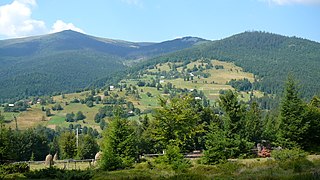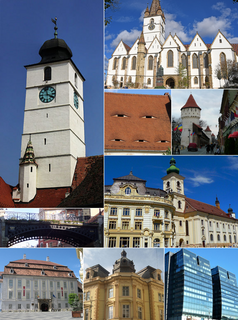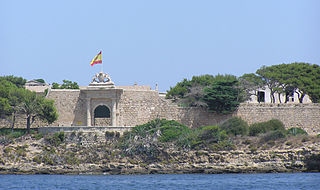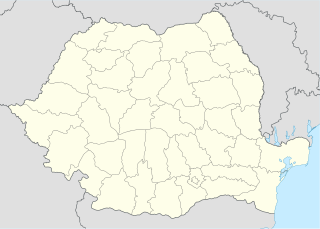
Lazaret is a district in Sibiu, Romania. It is located in the eastern part of the city.

Lazaret is a district in Sibiu, Romania. It is located in the eastern part of the city.
On the current location of the train station, there was a small Dominican monastery that was relocated into the citadel of Sibiu. The former monastery buildings were put to use as a lazaret, to house and quarantine the sick and isolate them from the general population of the citadel.
With the development of the city, the lazaret was pushed further to the outskirts, until it was put out of use, the region becoming a residential district. [1]

Transylvania is a historical region that is located in central Romania. Bound on the east and south by its natural borders, the Carpathian mountain range, historical Transylvania extended westward to the Apuseni Mountains. The term sometimes encompasses not only Transylvania proper, but also parts of the historical regions of Crișana and Maramureș, and occasionally the Romanian part of Banat.

Aiud is a city located in Alba county, Transylvania, Romania. The city's population is 22,876. It has the status of municipality and is the 2nd-largest city in the county, after county seat Alba Iulia. The city derives its name ultimately from Saint Giles (Aegidius), to whom the first church in the settlement was dedicated when built.

Sibiu is a city in Transylvania, a historical region of Romania. Located some 275 km (171 mi) north-west of Bucharest, the city straddles the Cibin River, a tributary of the river Olt. Now the capital of the Sibiu County, between 1692 and 1791 and 1849–65 Sibiu was also the capital of the Principality of Transylvania.

According to National Tourism Statistics 15.7 million domestic and foreign tourists stayed in overnight accommodations in 2018. Of these 2.2 million are recorded as foreign tourists.

A lazaretto or lazaret is a quarantine station for maritime travellers. Lazarets can be ships permanently at anchor, isolated islands, or mainland buildings. In some lazarets, postal items were also disinfected, usually by fumigation. This practice was still being done as late as 1936, albeit in rare cases. A leper colony administered by a Christian religious order was often called a lazar house, after the parable of Lazarus the beggar.

Peel Island is a small heritage-listed island located in Moreton Bay, east of Brisbane, in South East Queensland, Australia. The island is a locality within the local government area of Redland City. In the 2016 census, Peel Island had a population of 0 people.

The Cârța Monastery is a former Cistercian (Benedictine) monastery in the Țara Făgărașului region in southern Transylvania in Romania, currently an Evangelical Lutheran church belonging to the local Saxon community. It lies on the left bank of the Olt River, between the cities of Sibiu and Făgăraș, close to the villages of Cârța and Cârțișoara. The monastery was probably founded in 1202–1206 by monks from Igriș Abbey, and was disbanded in 1494, when the apostolic legate Ursus of Ursinis ratified Cârța Abbey's attachment to the Provostship nullius of Sibiu. The Cistercian monastery introduced and helped develop French Gothic art in the region.

Boița is a commune in Sibiu County, Transylvania, Romania, at the foothills of the Cindrel Mountains, 22 km south of the county capital Sibiu, in the Mărginimea Sibiului ethnographic area, on the main road between Sibiu and the southern part of Romania, the National road 7/European route 81, at the entrance of the Olt River defile. The commune is composed of four villages: Boița, Lazaret, Lotrioara (Latorvár) and Paltin. These were part of Tălmaciu town until 2004, when they were split off.

The Lotrioara is a right tributary of the river Olt in Romania. Its source is in the Lotru Mountains. It discharges into the Olt in Lazaret. Its length is 25 km (16 mi) and its basin size is 120 km2 (46 sq mi).

The Vad is a right tributary of the river Olt in Romania. It discharges into the Olt in Lazaret. Its length is 12 km (7.5 mi) and its basin size is 46 km2 (18 sq mi).
Țiglari is a district of Sibiu, Romania, situated in the northern part of the city. Its name is given by the former tile factory that was situated in this part of the city.

Valea Aurie is a residential district of Sibiu, Romania, situated in the south-western part of the city.
Vasile Aaron is a residential district in Sibiu, Romania, located in the eastern part of the city.
Ștrand is a residential district of Sibiu, Romania, located in the western part of the city.
Broscărie is a district located in the eastern part of Sibiu, Romania, next to the eastern industrial area.
Trei Stejari is a district near the center of Sibiu, Romania.
Lazaret Meljine is a fortress and a military hospital built by the Venetians in 1732 near the town of Herceg Novi (Montenegro) in the village of Meljine on the beach. This institution performed quarantine functions, and also gave permission for the import or export of various products. Lazaret survived to this day.

Petersberg Citadel in Erfurt, central Germany, is one of the largest and best preserved town fortresses in Europe. The citadel was built on Petersberg hill, in the north-western part of the old town centre from 1665, when Erfurt was governed by the Electorate of Mainz. It is surrounded by over two kilometres of stone walls and is 36 hectares in size.

Various lists of the Seven Wonders of Romania have been compiled from past to the present day, to catalogue Romania's most spectacular manmade structures.

The Eyes of Sibiu are the iconic eyebrow dormers on the roofs of Sibiu's houses. Sibiu lies in Transylvania, a historical region of Romania. The eyes, which are a symbol and a tourist attraction of the city, have given Sibiu the nicknames of The City with Eyes, The City Where Houses Don't Sleep and the portmanteau Seebiu. They vary in shape - most of them are trapezoid-shaped, others having rounded or elongated forms.